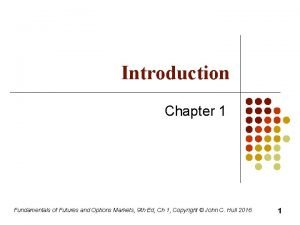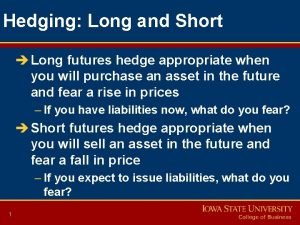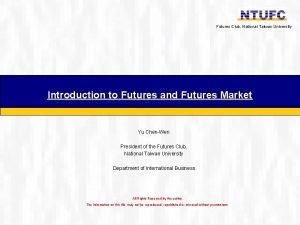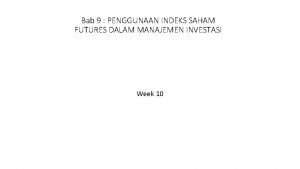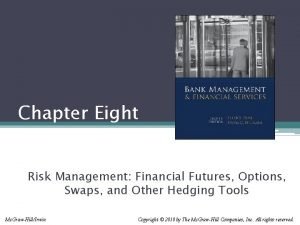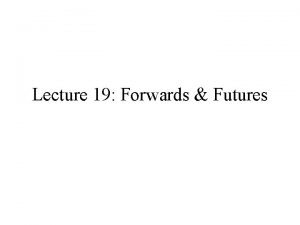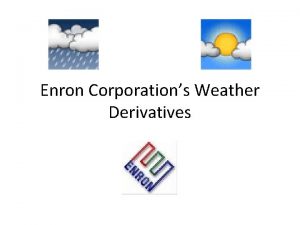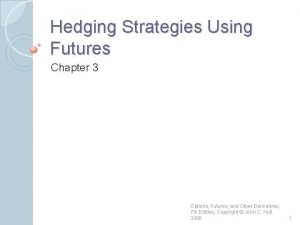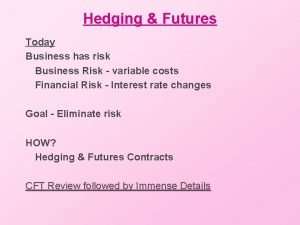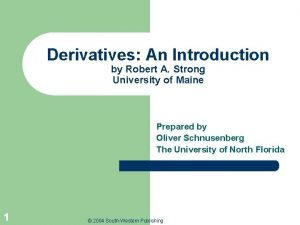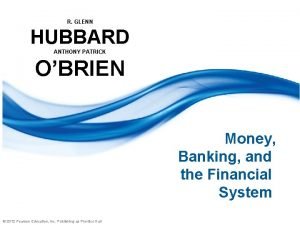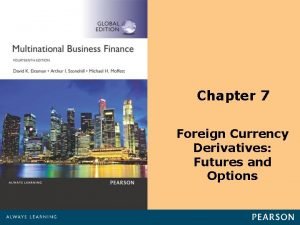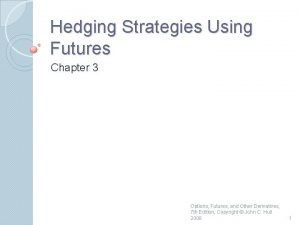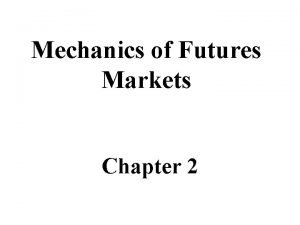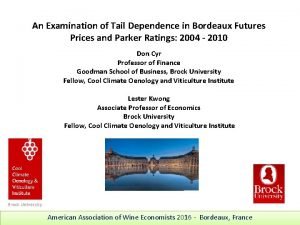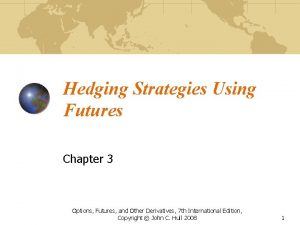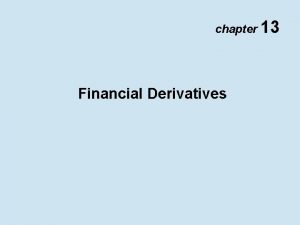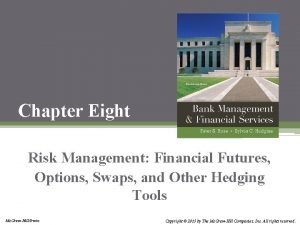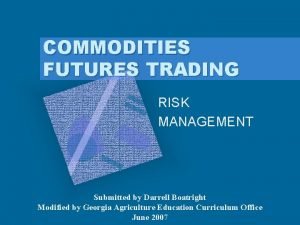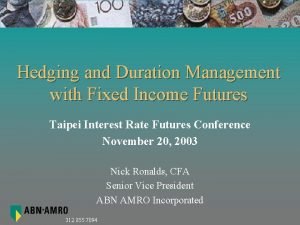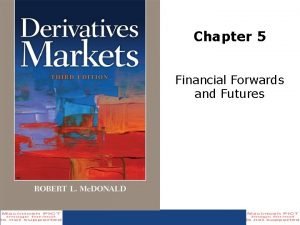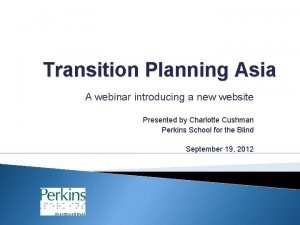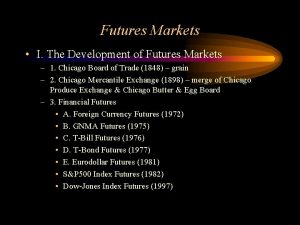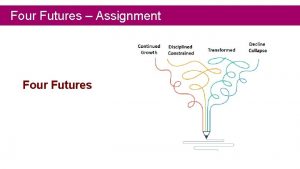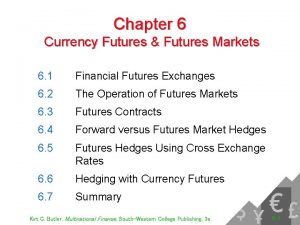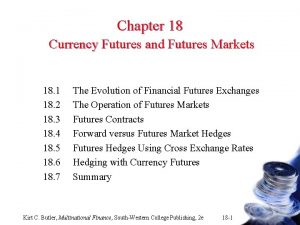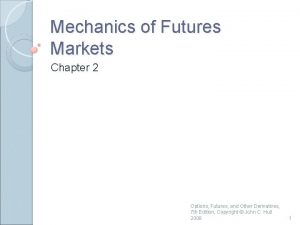Futures Topic 10 I Futures Markets 1 A






























































- Slides: 62

Futures Topic 10 I. Futures Markets • • 1

A. Forward vs. Futures Markets 1. Forward contracting involves a contract initiated at one time and performance in accordance with the terms of the contract occurring at a subsequent time. • Example: A highly prized St. Bernard has just given birth to a litter of pups. A buyer agrees to buy one pup for $400. The exchange cannot take place for 6 weeks. The buyer and seller agree to exchange (sell) the pup in 6 weeks for $400. This is a forward contract; both parties are obligated to go through with the deal. 2

A. Forward vs. Futures Markets (continued) 2. Differences b/w Forward and Futures Markets a. The Organized Exchange b. Contract Terms--standardized item c. The Clearinghouse--takes no active position in the market, but interposes itself between all parties to every transaction. The number of contracts bought must always equal the number of contracts sold. 3

A. Forward vs. Futures Markets (continued) d. The Requirement for Daily Resettlement Assume that the contract closes on May 2 at 168¢/bushel. This means that A has sustained a loss of 3¢. Since there are 5000 bu. in the contract this represents a loss of $150. This amount is deducted from the margin deposited with the broker. 4

A. Forward vs. Futures Markets (continued) Assume initial margin was $1400 and maintenance margin is $1100. A has already sustained a loss of $150 so the value of the margin account is $1250. If the price drops by 4¢ the following day another $200 loss is registered. The value of the margin account is down to $1050, below the maintenance margin. This means A will be required to bring the margin account back to $1400. 5

Table 1 Futures Market Obligations. The oat contract is traded by the CBT. Each contract is for 5000 bushels, and prices quoted in cents per bushel. 6

Table 1 (continued) A May 1: Buys 1 Sept. contract for oats at 171 cents/bushel B Sells 1 Sept. contract for oats at 171 cents/bushel A Buys 1 Sept. contract for oats at 171 cents/bushel Clearinghouse Agrees to deliver to A, a Sept. 1 contract for oats at 171 cents/bushel B Sells 1 Sept. contract for oats at 171 cents/bushel Clearinghouse Agrees to receive from B a 1 Sept. contract for oats at 171 cents/bushel 7

Table 1 (continued) 3. A Reversing Trade--brings a trader’s net position in some futures contract back to zero. Without a reversing trade the investor will be required to either deliver the product at the contract price (if the contract was sold) or purchase the product (if the contract was purchased). 8

B. Purposes of Futures Markets Meets the needs of three groups of futures market users: • 1. Those who wish to discover information about future prices of commodities (suppliers) • 2. Those who wish to speculate (speculators) • 3. Those who wish to transfer risk to some other party (hedgers) 9

C. Taxation of Futures Contracts All paper gains and losses on futures positions must be treated as though they were realized at the end of the tax year. The IRS must get its due on an annual basis. 10

Futures Topic 10 II. Futures Markets Terms 11

A. Reading Futures Prices (Contracts) 1. The Product 2. The Exchange 3. Size of the Contract 4. Method of Valuing Contract 5. The delivery month 12

A. Reading Futures Prices (Prices) 1. Opening 2. High 3. Low 4. Settlement Price at which the contracts are settled at the close of trading for the day Typically the last trading price for the day 13

B. The Basis. . . is the current cash price of a particular commodity minus the price of a futures contract for the same commodity. BASIS = CURRENT CASH PRICE - FP 14

B. The Basis (continued) Example: Gold Prices and the Basis: 12/16/10 Spot Price Basis Cash JAN ‘ 11 APR ‘ 11 JUN ‘ 11 OCT ’ 11 DEC ‘ 11 FEB ‘ 12 $1386. 00 1388. 40 1391. 00 1393. 20 1397. 60 1400. 10 1402. 80 -$2. 40 -$5. 00 -$7. 20 -$11. 60 -$14. 10 -$16. 80 15

B. The Basis (continued) Prices Cash Basis Present Futures Maturity 16 Time

B. The Basis (continued) 1. Relation between Cash & Futures 2. Spreads The difference between two futures prices (same type of contract) at two different points in time 17

Futures Topic 10 III. Trading Commodities 18

A. Margin Sometimes called the deposit, the margin represents security to cover any loss in the market value of the contract that may result from adverse price changes. This is the cost of trading in the futures market. 19

Initial Margins and Maintenance Margins Contract Exchange Symbol Initial Margin Maintenance Margin Cocoa ICE CC $1890 $1350 Coffee ICE KC $6300 $4500 Corn CBOT C $2025 $1500 Crude Oil NYMEX CL $5063 $3750 Feeder Cattle CME FC $1688 $1250 Gold COMEX GC $6075 $4500 Orange Juice ICE OJ $1960 $1400 Pork Bellies CME PB $2025 $1500 Silver COMEX SI $10463 $7750 Soybeans CBOT S $4388 $3250 Unlead/Gas NYMEX HU $5400 $4000 Wheat CBOT W $3375 $2500 ICE is the Intercontinental Exchange CBOT is the Chicago Board of Trade NYMEX is the New York Mercantile Exchange CME is the Chicago Mercantile Exchange COMEX is part of the NYMEX that deals with precious metals 20

Commodity Quotes Contract Exchange Symbol Quoted In and Size of Contract: Cocoa ICE CC $/metric ton (10 metric tons) Coffee ICE KC Cents/lb. (37, 500 pounds) Corn CBOT C Cents/ bushel (5000 BU) Crude Oil NYMEX CL $/per barrel (1, 000 U. S. barrels) Feeder Cattle CME FC Cents/lb. (40, 000 lbs. ) Gold COMEX GC $/per ounce (100 ounces) Orange Juice ICE OJ Cents/lb. (15, 000 lbs. ) Pork Bellies CME PB Silver COMEX SI $/ounce (5, 000 ounces) Soybeans CBOT S Cents/bushel (5, 000 bushels) Unlead/Gas NYMEX HU $/gallon (42, 000 gallons) Wheat CBOT W Cents/bushel (5, 000 bushels) 21

B. Speculating Assume a speculator buys a JUNE contract at $1393. 20 by depositing the required margin of $7, 500. One gold contract = 100 troy ounces, it has a market value of $139, 320. Hence margin is: $7, 500/$139, 320 = 5. 38% 22

B. Speculating (continued) 1. If Gold contract goes up to $1400/ounce by May, then: Profit = $1400 - $1393. 20 = $6. 80*100 Return = $680/$7500 = 9. 1% 2. If Gold contract goes down to $1386. 40/ounce by May, then: Profit = $1386. 40 - $1393. 20 = - 6. 80*100 - 680/7500 = -9. 1% 23

B. Speculating (continued) 3. Assume the speculator shorts by selling the JUNE contract. If price decreases then: Receives: ($1393. 20 - $1386. 40) = $6. 80*100 Profit: $680 Return: $680/$7500 = 9. 1% 24

C. Spreading Combining two or more different contracts into one investment position that offers the potential for generating a modest profit 25

C. Spreading (continued) Ex: Buy (long) 1 Corn contract at 640 Sell (short) 1 Corn contract at 645 Close out by: 1. Selling the long contract at 648 2. Buy a short contract at 648 Profit: Long: 648 -640 = 8¢ Short: 645 -648 = -3¢ Profit: = 10¢ -3¢ = 5¢ 5¢ * 5000 bu. = $250 Net 26

D. Hedging. . . is an attempt to protect a position in a commodity Example: Suppose a manufacturer uses platinum as a basic raw material in the production of catalytic converters. Assume: Platinum sells for $1600/ounce today. By years end the price is expected to increase substantially. 27

Hedging Example (continued) 1. Producer buys Platinum futures at $1620. Assume spot price increases in 8 months to $1710/ounce. And the price of the contract has increased to $1740/ounce. One contract represents 50 ounces. 2. Profit: a. In the contract: $1740 - $1620 = $120*50 = $6000 b. In the spot market: $1710 - $1600 = $110*50 =($5500) NET GAIN = $500 28

Hedging Example (continued) The producer would have experienced a $5500 additional cost if he did not buy futures contracts. The net result of this hedge is that the producer has eliminated the potential loss in profits by buying the futures contract: In essence the producer has actually netted $500. 29

Futures Topic 10 IV. Financial Futures 30

A. Assets 1. Foreign currencies 2. Interest Rates 3. Stocks Indexes 4. Some single stocks 5. Narrow-based Indexes 6. Exchange Traded Funds 31

B. Markets 1. Foreign Currencies a. British Pound (GBD) b. Swiss Franc (CHF) c. Canadian Dollar (CAD) d. Japanese Yen (JPY) g. Australian dollar (AUD) h. Euro (EUR) 32

B. Markets (continued) 2. Interest Rates a. 90 -day T-bills b. 1 -Year T-bills c. 90 -day Bank CD’s d. 90 -day Eurodollar Deposits e. GNMA pass through Certificates f. US Treasury Notes g. US Treasury Bonds h. Municipal bonds i. Various 30 -day interest rate contracts (Fed funds) j. Various foreign government bonds (i. e. bonds issued by the British, German, and Canadian governments). 33

B. Markets (continued) 3. Stock Index Futures a. DJIA b. S & P Stock Index c. NYSE Composite Stock Index d. Value Line Composite e. Nasdaq 100 Index f. Russell 2000 Index 34

C. Contract Specifications 1. On currencies, contracts entitle holders to a claim on a certain amount of foreign currency. 35

C. Contract Specifications (continued) Examples Foreign Currencies: 25, 000£ British 12, 500, 000 Japanese Yen Financial Future: $100, 000 GNMA & T-Bonds $1, 000 T-Bills Stock Futures: CASH 36

D. Financial Futures Relationship with Interest Rates 1. Long Position--involves the purchase of a futures contract and the expectation that interest rates will fall. When the futures contract is purchased the underlying securities will increase in value when interest rates fall. Therefore, the value of the futures contract will increase. 37

D. Financial Futures Relationship with Interest Rates 1. Long Position--involves the purchase of a futures contract and the expectation that interest rates will fall. When the futures contract is purchased the underlying securities will increase in value when interest rates fall. Therefore, the value of the futures contract will increase. 38

D. Financial Futures Relationship with Interest Rates Example: December T-Bonds Futures price is 97 -17. This translates to a value of 97 17/32% or. 9753125 or an underlying value of $97, 531. 25. If interest rates go up then the value of the futures contract will decrease. If interest rates go down the value of the futures contract will increase. 39

D. Financial Futures Relationship with Interest Rates 2. Short Position--involves the sale of a futures contract and the expectation that interest rates will increase. When interest rates increase the underlying assets will decrease in value and the contract will also decrease in value. This enables you to purchase a contract (reverse trade) at a lower price than you sold it for. 40

D. Financial Futures Relationship with Interest Rates Example: Assume you buy a December contract at 9717 and interest rates increase, thus resulting in a lower contract price, say down to 90 -00. Loss = 7 17/32% * $100, 000 = - $7, 531. 25 If you sold the contract originally, (short) you would have experienced a gain if interest rates increased. Assume the same situation, then the short gain is: 7 17/32% * $100, 000 = +$7, 531. 25 41

D. Financial Futures Relationship with Interest Rates Using Futures Contracts to Hedge Against Increasing Interest Rates 1. Assume interest rates increase over a six month period of March 1 to August from 3% to 5% as measured by the prime rate. 2. Assume a Developer takes out a construction loan of $50 million at prime + 2 points for six months. 42

D. Financial Futures Relationship with Interest Rates l 1. Long Position--involves the purchase of a futures contract and the expectation that interest rates will fall. When the futures contract is purchased the underlying securities will increase in value when interest rates fall. Therefore, the value of the futures contract will increase. 43

D. Financial Futures Relationship with Interest Rates l Example: December T-Bonds Futures price is 67 -17. This translates to a value of 67 17/32% or. 6753125 or an underlying value of $67, 531. 25. • If interest rates go up then the value of the • futures contract will decrease. If interest rates go down the value of the futures contract will increase. 44

D. Financial Futures Relationship with Interest Rates l 2. Short Position--involves the sale of a futures contract and the expectation that interest rates will increase. When interest rates increase the underlying assets will decrease in value and the contract will also decrease in value. This enables you to purchase a contract (reverse trade) at a lower price than you sold it for. 45

D. Financial Futures Relationship with Interest Rates l l Example: Assume you buy a December contract at 67 -17 and interest rates increase, thus resulting in a lower contract price, say down to 60 -00. • Loss = 7 17/32% * $100, 000 = - $7, 531. 25 If you sold the contract originally, (short) you would have experienced a gain if interest rates increased. Assume the same situation, then the short gain is: 7 17/32% * $100, 000 = +$7, 531. 25 46

D. Hedging with Futures Contracts l Using Futures Contracts to Hedge Against Increasing Interest Rates • 1. • Assume interest rates increase over a six month period of March 1 to August from 11% to 13% as measured by the prime rate. 2. Assume a Developer takes out a construction loan of $50 million at prime + 2 points for six months. 47

D. Hedging with Futures Contracts l l l 3. To hedge the loan the Hedge Position is determined by: • $50, 000/100, 000 = 500 futures contracts = 1: 1 Hedge 4. At a price of 67 -17 for December contracts the total value would be: • $67, 531. 25/contract * 500 = $33, 765, 625 But the total cost to control these assets is margin/contract times 500. • $2000 * 500 = $1, 000 48

D. Hedging with Futures Contracts l 5. Assume on August 31, a developer “reverses” or closes his position by buying back December futures contracts at 65 -05. The lower price is due to increased interest rates. • Profits: • (67 -17) - (65 -05) = 2 -12 or 2 12/32% • . 02375 * $100, 000 = $2, 375/contract • or $1, 187, 500 for 500 contracts 49

D. Hedging with Futures Contracts l l 6. A “Do-Nothing” strategy would have resulted in $370, 558 interest (additional) due to the rising rates. 7. Therefore, the net hedge position would result in a total gain of $816, 942 i. e. ($1, 187, 500 - $370, 558) 50

D. Hedging with Futures Contracts l 8. Hence, in this case a perfect hedge could have been achieved at a hedge ratio of: 1 to. 312 that is: [ 156/500 ] rather than 1 to 1: $370, 558/2, 375 = 156 51

G. Futures Options Relationship with Interest Rates l 1. Since the futures option (options on futures represents a call (right to buy a futures contract at a specific price) or a put (right to sell a futures contract at a specific price) then: • Call: decreases in value when the interest rates increase because the underlying futures asset is decreasing in value. • Put: increases in value when the interest rates increase because the underlying futures asset has decreased in value. 52

Futures Options Example Calls Strike 66 68 June 2 -31 1 -13 Sept 2 -36 1 -33 Dec 2 -32 1 -37 66 68 0 -24 1 -05 0 -63 1 -59 1 -31 2 -16 Puts These are traded in 1/64’s 53

H. Using Futures Options to Hedge l . . . Against Increasing Prime Rates • 1. • 2. • Assume same increasing rates. Since the Developer seeks protection against rising interest rates he must buy PUT options. 3. To establish a HEDGE Position similar to that of the futures example, the Developer buys put options with a strike price of 68 with a premium of 2 -16 which is equal to: • 2 16/64% * $100, 000 = $2, 250 per contract 54

H. Using Futures Options to Hedge (continued) • To establish a 1: 1 Hedge, the developer buys 500 contracts. • This establishes a comparative base with the • 4. futures contracts. The Developer now closes out his position in the options market on August 31 (same as futures example by selling the PUT options he purchased back in March. The price for the December puts is now 3 -23 55

H. Using Futures Options to Hedge (continued) • Therefore: • 3 23/64% x $100, 000 = $3, 359. 38 • Gain: $3, 359. 38 - $2, 250. 22 = $1, 109. 38 contract • Total Gain: $1, 109. 38 * 500 = $554, 690 • 5. • Net Hedge position would result in a gain of: $554, 690 - $370, 558 = $184, 132 6. A perfect Hedge could have been achieved with a hedge ratio of: • Initial: 370, 558/gain: • 334/500 = 1 to. 668 1, 109. 38 = 334 56

F. Single Stock Futures Single stock futures (SSF) are futures for single stocks of mostly large companies, such as IBM, Intel, and Microsoft. As with all security futures, a margin of only 20% is required to take a position in an SSF, in contrast to the typical 50% of a stock purchase, and transaction costs may be less, especially foreign stocks in countries with high transaction taxes and clearing charges. An SSF contract calls for the delivery of 100 shares of the underlying stock on the expiration day; however, some SSF’s may stipulate a cash settlement. Minimum price changes are a penny per share, or $1 per contract, with no daily price change limitations. 57

Example of Using SSF vs. Long Position and Buying on Margin Initial Investment Stock Price Increases to $36 Profit Rate of Return Stock Price Decreases to $24 Loss Rate of Return Buy Stock $3, 000 $3, 600 $600 20% $2400 -600 -20% Margin $1, 500 $3, 600 $600 40% $2400 -600 -40% $600 $3, 600 $600 100% $2400 -600 -100% Buy SSF 58

F. Single Stock Futures Example - Using Single Stock Futures as a Hedge Consider an investor who has bought 100 shares of Dow Chemical (NYSE: DOW) at $30. In July, the stock is trading at $35. The investor is happy with the unrealized gain of $5 per share but is concerned that in a stock as volatile as DOW, the gain could be wiped out in one bad day. The investor wishes to keep the stock at least until September, however, because of an upcoming dividend payment. To hedge, the investor sells a $35 September SSF contract - whether the stock rises or declines, the investor has locked in the $5 -per-share gain. In August, the investor sells the stock at the market price and buys back the SSF contract. 59

End 60

61

Example of Using SSF Short 62
 Mechanics of futures markets
Mechanics of futures markets Forward vs option
Forward vs option Mechanics of futures markets
Mechanics of futures markets Mechanics of futures market
Mechanics of futures market A clincher sentence is
A clincher sentence is Narrow topic examples
Narrow topic examples Esf futures
Esf futures Long hedge and short hedge
Long hedge and short hedge Harga saham samsung
Harga saham samsung Single stock dividend futures
Single stock dividend futures Futures club
Futures club Saham futures
Saham futures Futures definition
Futures definition Options futures and risk management
Options futures and risk management Managed futures glossary
Managed futures glossary Fair value of futures contract
Fair value of futures contract Options, futures, and other derivatives
Options, futures, and other derivatives Experiential futures ladder
Experiential futures ladder Bright future scholarship
Bright future scholarship Bright futures screening guidelines
Bright futures screening guidelines Futures exchange
Futures exchange City futures research centre
City futures research centre Bright futures scholarship
Bright futures scholarship Hedging strategies using futures
Hedging strategies using futures Enron weather futures
Enron weather futures Hedging interest rate risk with futures
Hedging interest rate risk with futures Futures price formula
Futures price formula A pedagogy of multiliteracies: designing social futures
A pedagogy of multiliteracies: designing social futures Futures market
Futures market Futures exchange
Futures exchange Add-on yield
Add-on yield Put call parity
Put call parity Eurodollar packs
Eurodollar packs Hedging strategies using futures
Hedging strategies using futures Penilaian indeks saham berjangka
Penilaian indeks saham berjangka Tobacco free futures
Tobacco free futures Futures contract example
Futures contract example Futures definition
Futures definition Mechanics of futures market
Mechanics of futures market Istoxx factor indexes
Istoxx factor indexes Futures for you
Futures for you Cheapest to deliver
Cheapest to deliver Currency futures contracts sold on an exchange
Currency futures contracts sold on an exchange What is futures trading
What is futures trading Mistra urban futures
Mistra urban futures What is futures trading
What is futures trading Eurex btp futures
Eurex btp futures Currency futures
Currency futures Hedge ratio
Hedge ratio Mechanics of futures market
Mechanics of futures market Hesa data futures
Hesa data futures Futures bordeaux wijnen
Futures bordeaux wijnen Hedging strategies using futures and options
Hedging strategies using futures and options Advantages and disadvantages of derivatives
Advantages and disadvantages of derivatives Options futures and risk management
Options futures and risk management Futures trading risk management
Futures trading risk management Fixed income futures
Fixed income futures Euro-btp
Euro-btp Language futures
Language futures Synthetic forward contract
Synthetic forward contract Nhs futures platform
Nhs futures platform Pfp personal futures planning
Pfp personal futures planning Sil futures
Sil futures

